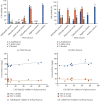Antioxidant, Anticancer, and PXR-Dependent CYP3A4 Attributes of Schweinfurthia papilionacea (Burm.f.) Boiss., Tricholepis glaberrima DC. and Viola stocksii Boiss
- PMID: 35222807
- PMCID: PMC8865984
- DOI: 10.1155/2022/9366223
Antioxidant, Anticancer, and PXR-Dependent CYP3A4 Attributes of Schweinfurthia papilionacea (Burm.f.) Boiss., Tricholepis glaberrima DC. and Viola stocksii Boiss
Retraction in
-
Retracted: Antioxidant, Anticancer, and PXR-Dependent CYP3A4 Attributes of Schweinfurthia papilionacea (Burm.f.) Boiss., Tricholepis glaberrima DC. and Viola stocksii Boiss.Oxid Med Cell Longev. 2024 Jan 9;2024:9780101. doi: 10.1155/2024/9780101. eCollection 2024. Oxid Med Cell Longev. 2024. PMID: 38234545 Free PMC article.
Abstract
Present study established the biological potential of Schweinfurthia papilionacea, Tricholepis glaberrima and Viola stocksii extracts for their potential applications in drug formulations. Initially, FTIR was performed to ascertain functional groups and then plant extracts were prepared using five solvents depending on the polarity. Total phenolic contents were observed in the range of 36.36 ± 1.08 mg GAE/g to 95.55 ± 2.46 mg GAE/g while flavonoid contents were found in the range of 10.51 ± 0.25 mg QE/g to 22.17 ± 1.79 mg QE/g. Antioxidant activity was determined using TRP, CUPRAC, TAC and DPPH assays and was recorded highest in S. papilionacea followed by T. glaberrima extracts. TPC and TFC were found to be strongly correlated with TRP (r > 0.50), CUPRAC (r > 0.53) and DPPH (r = 0.31 and 0.72) assay while weakly correlated with TAC (r = 0.08 and 0.03) as determined by Pearson correlation analysis. Anticancer activity showed that S. papilionacea chloroform extracts possess highest cell viability (85.04 ± 4.24%) against HepG2 cell lines while T. glaberrima chloroform extracts exhibited highest activity (82.80 ± 2.68%) against HT144 cell lines. Afterwards, highest PXR activation was observed in T. glaberrima (3.49 ± 0.34 μg/mL fold) at 60 μg/mL and was correlated with increase in CYP3A4 activity (15.0 ± 3.00 μg/mL IC50 value). Furthermore, antimalarial activity revealed >47600 IC50 value against P. falciparum D6 and P. falciparum W2 and antimicrobial assay indicated highest activity (32 ± 2.80 mm) in S. papilionacea against C. neoformans. At the end, GC-MS analysis of n-hexane plant extracts showed 99.104% of total identified compounds in T. glaberrima and 94.31% in V. stocksii. In conclusion, present study provides insight about the different biological potentials of S. papilionacea and T. glaberrima extracts that rationalize the applications of these extracts in functional foods and herbal drugs for the management of oxidative-stress related diseases, antimicrobial infections and liver and skin cancer.
Copyright © 2022 Amir Shahbaz et al.
Conflict of interest statement
All authors declare that they have no competing interest.
Figures






Similar articles
-
Retracted: Antioxidant, Anticancer, and PXR-Dependent CYP3A4 Attributes of Schweinfurthia papilionacea (Burm.f.) Boiss., Tricholepis glaberrima DC. and Viola stocksii Boiss.Oxid Med Cell Longev. 2024 Jan 9;2024:9780101. doi: 10.1155/2024/9780101. eCollection 2024. Oxid Med Cell Longev. 2024. PMID: 38234545 Free PMC article.
-
Chemical composition, antioxidant, antimicrobial, and anticancer activities of Mahonia napaulensis DC. bark from Nepal.BMC Complement Med Ther. 2025 Mar 14;25(1):105. doi: 10.1186/s12906-025-04806-0. BMC Complement Med Ther. 2025. PMID: 40087695 Free PMC article.
-
Appraisal of phytochemical and in vitro biological attributes of an unexplored folklore: Rhus Punjabensis Stewart.BMC Complement Altern Med. 2017 Mar 9;17(1):146. doi: 10.1186/s12906-017-1659-6. BMC Complement Altern Med. 2017. PMID: 28274230 Free PMC article.
-
Phytochemical constituents and biological activities of different extracts of Strobilanthes crispus (L.) Bremek leaves grown in different locations of Malaysia.BMC Complement Altern Med. 2015 Nov 27;15(1):422. doi: 10.1186/s12906-015-0873-3. BMC Complement Altern Med. 2015. PMID: 26613959 Free PMC article.
-
Antioxidant activities of ethanol extracts and fractions of Crescentia cujete leaves and stem bark and the involvement of phenolic compounds.BMC Complement Altern Med. 2014 Feb 4;14:45. doi: 10.1186/1472-6882-14-45. BMC Complement Altern Med. 2014. PMID: 24495381 Free PMC article.
Cited by
-
Retracted: Antioxidant, Anticancer, and PXR-Dependent CYP3A4 Attributes of Schweinfurthia papilionacea (Burm.f.) Boiss., Tricholepis glaberrima DC. and Viola stocksii Boiss.Oxid Med Cell Longev. 2024 Jan 9;2024:9780101. doi: 10.1155/2024/9780101. eCollection 2024. Oxid Med Cell Longev. 2024. PMID: 38234545 Free PMC article.
-
Assessment of phytochemicals, antioxidant, anti-hemolytic, anti-inflammatory and anti-cancer potential of flowers, leaves and stem extracts of.J Tradit Chin Med. 2024 Aug;44(4):804-712. doi: 10.19852/j.cnki.jtcm.2024.04.001. J Tradit Chin Med. 2024. PMID: 39066541 Free PMC article.
References
-
- Humber J. M. The role of complementary and alternative medicine: accommodating pluralism. The Journal of the American Medical Association . 2002;288(13):1655–1656.
-
- Manek N. J., Crowson C. S., Ottenberg A. L., Curlin F. A., Kaptchuk T. J., Tilburt J. C. What rheumatologists in the United States think of complementary and alternative medicine: results of a national survey. BMC Complementary and Alternative Medicine . 2010;10(1):1–8. doi: 10.1186/1472-6882-10-5. - DOI - PMC - PubMed
-
- Ruben R., Slingerland M., Nijhoff H. The agro-food chains and networks for development . New York, NY: Springer Science & Business Media; 2006.
Publication types
MeSH terms
Substances
LinkOut - more resources
Full Text Sources
Medical
Miscellaneous

